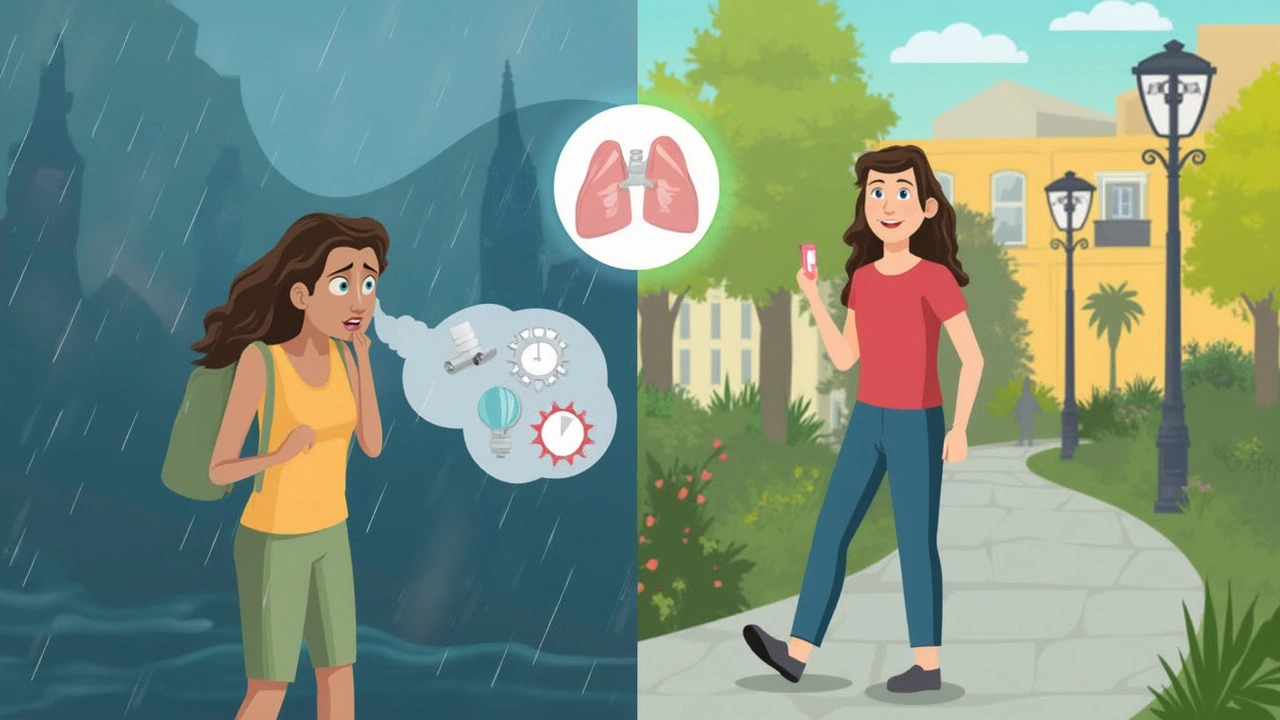Why Long-Acting Beta Agonists Matter in Today’s Respiratory Care
For anyone who deals with asthma or COPD, that daily wheeze or breathlessness is more than an inconvenience—it colors every little moment. LABA medicines (long-acting beta agonists) like formoterol have really rewritten the story for many folks. Instead of waiting for rescue inhalers to work, LABAs help keep airways relaxed and open long-term, holding attacks at bay for half a day or more. Sounds dreamlike, right? But knowing what to reach for isn’t as simple as picking the first prescription you’re handed.
A big draw of formoterol is its speed—it kicks in noticeably faster than some older LABAs. That’s why it’s often built into combo inhalers, like those for folks who want both quick and steady relief. With asthma rates rising globally and COPD still holding its grip as a leading cause of disability, knowing your options is more important than ever. Your neighbor might swear by one brand, while your cousin’s doctor is pushing a newer molecule. So what’s making people look at formoterol alternatives now? It comes down to side effects, cost, convenience, and sometimes just the hope for better results or fewer flares.
LABAs aren’t like rescue inhalers. They’re part of a maintenance routine—a bit like my cat Whiskers’ daily feeding: set it and (almost) forget it. But as new data and drugs pop up, the landscape shifts. So, let’s break down the essentials everyone should know before their next checkup, including the in-demand picks and what's on the research horizon.
How Formoterol Works—and Why People Switch LABAs
Formoterol is a go-to because of its unique balance: it acts fast (within minutes) and lasts up to twelve hours. That rapid action is helpful in combo inhalers, as it fills the gap between maintenance and rescue roles. But for some, even formoterol has its quirks—like the jitters, racing heart, or dry throat. These may not bother everyone, but if you’re the unlucky type (or your doctor’s a perfectionist), seeking newer or different meds is normal.
The reason behind people switching has changed a bit. Back in the day, most patients just stuck with whatever option was cheapest or covered by insurance. Now, with so many generics and slight molecular tweaks on the market, you can actually look for an inhaler that best fits your daily rhythm. Maybe you hate that artificial taste some inhalers leave. Maybe you need something that works overnight because your symptoms love midnight drama. Maybe, just maybe, your insurance flipped the script and now your medicine jumped in price. Whatever the reason, it’s smart to know the next best choice.
Doctors generally look for LABAs that suit the type and severity of your disease. If you’re managing both asthma and seasonal allergies, that might nudge them toward one combo over another. If you’re older, they might steer away from a med with high cardiac risk. For people who have trouble sticking to twice-a-day dosing, some newer inhalers do the job in a single puff per day, which is a hefty recruiting pitch.
Meet the Contenders: Popular LABAs Taking Center Stage
Besides formoterol, the LABA medicines list isn’t short. Salmeterol is probably the next best-known name; it works a little slower, taking about 30 minutes for full effect, but it also lasts around 12 hours. It has a massive track record for stability, and you’ll see it paired up in things like Advair.
Indacaterol is a once-daily LABA that’s gained traction, especially for COPD folks who really want fewer doses. Its action stretches up to 24 hours in a lot of patients. There’s also olodaterol—another once-daily, with a profile that matches up for patients with chronic symptoms but who want a simpler schedule. Then, there’s vilanterol: you’ll spot it in double or triple therapy combos like Breo and Trelegy. More options mean more ways to tailor care instead of settling.
And not every inhaler is built the same. Some require sharp, hard puffs to get the dose out, while others use a soft-mist delivery for anyone who struggles to coordinate their breath. There’s even a new wave of “smart inhalers” with built-in dose trackers for the forgetful crowd. The key differences aren’t just in the molecules—they’re in the devices and the user experience too.
Here’s a quick snapshot comparing major LABAs:
| LABA | Time to Onset | Duration | Popular Combos |
|---|---|---|---|
| Formoterol | 1-3 min | 12 hrs | Symbicort, Dulera |
| Salmeterol | 30 min | 12 hrs | Advair, Seretide |
| Indacaterol | 5 min | 24 hrs | Ultibro |
| Olodaterol | 10-20 min | 24 hrs | Stiolto |
| Vilanterol | 15 min | 24 hrs | Breo, Trelegy |
So, whether you want something quick, long-acting, or just easy on your pocket, there are plenty of options to discuss next time your provider asks, “How’s your breathing been?”

Why Choose a Formoterol Alternative? Real-World Tips and Insights
People choose formoterol alternatives for all kinds of practical reasons. Sometimes it’s not about you, but your pharmacy—certain brands go out of stock or suddenly spike in price. Even insurance covers, or doesn’t, seemingly at random. Then, there’s good old trial and error. Maybe a patient on formoterol still wakes up at 2 AM coughing, while their friend on vilanterol is sleeping like a log.
If you’re considering a switch—or your doctor is nudging you to try something else—get specific. Bring up your daily timing troubles. Tell them about morning or evening symptoms, and be clear about any side effects, even ones that seem minor. Some people notice specific issues like tremors, cramps, or even just that annoying dry mouth feeling. There are small tweaks your provider can make, from trying a different dosing schedule to switching devices.
A tip that’s often missed: make sure you’re using your inhaler properly. It’s funny (or tragic), but studies keep showing that half of patients aren’t getting a full dose because the technique isn’t quite right. Most offices, or even your local pharmacy, can show you, or you can check online demos from medical websites. Don’t brush it off—getting the basics perfect is worth as much as changing meds.
- Ask if your inhaler is best for your age and dexterity. Some require strong inhaling, some don’t.
- Keep a diary for a couple weeks before your checkup, tracking symptoms and any side effects.
- Cost can differ a lot between brands—look up copay or pharmacy savings cards.
- If you have other health issues (like heart problems), check which LABAs are safest.
- Discuss with your doc if combo inhalers (that mix a LABA with a steroid or anticholinergic) make more sense—they can help with control but sometimes cost more.
If you’re hunting for detailed breakdowns, I’ve found this formoterol alternatives resource handy. It lays out specific swap options and their pros and cons, with an eye on those with COPD.
Emerging Trends: The Future of LABA Medicines and Smart Inhalers
Change in medicines never slows. Over the last five years, smart inhaler tech has really taken off. Some now come with reminders, sensors for correct inhaling, and Bluetooth connections that share your use patterns with your care team. There’s new research on once-daily combos that stretch even longer, aiming to cut symptoms down with even less maintenance work for the patient.
Scientists aren’t just looking for faster meds—they’re also trying to reduce the risk of tolerance, where the drug slowly loses its zip. This means next-gen LABAs might combine several pathways or use slightly altered molecules that hit your receptors more gently, lowering side effects like shakiness or headaches. There’s even buzz about adding anti-inflammatory effects to LABAs themselves, so you might one day get a combo’s power from a single molecule.
One big trend is the rise of “triple therapy” inhalers. These combine a LABA, a steroid, and a long-acting muscarinic antagonist (LAMA). They’re especially helpful for people who just can’t get good control with doubles, and they seem to help folks who end up in the ER too often. Expect more triple therapies to hit the shelves soon.
Another notable shift: environmental impact. The propellants in some inhalers were big climate polluters, so manufacturers are moving to greener delivery systems. It’s a slow rollout, but the push for sustainability is real. The inhalers of the future might be just as much about clean air inside your lungs as outside.
Finally, access is getting better—especially globally. A lot of these newer or improved LABAs are being scaled up in generic forms, which means more competition and price drops. That’s huge for people in countries where branded meds are a luxury. Pay attention to changing guidelines too; as new safety data rolls in, doctors are adjusting their go-to prescriptions.
Deciding What’s Next: Making the Most of Your LABA Choices
It’s totally normal to feel overwhelmed when staring at a list of inhaler names longer than a grocery receipt. Start by thinking about what matters most—speed, duration, side effects, cost, or just the feel of the inhaler in your hand. Let your daily life steer the conversation. If you’re always on the go, once-a-day inhalers might blend better with your schedule. If you hate that anxious, jittery feeling, tweaking meds could help more than you’d think.
Don’t forget to loop your healthcare team in—they see every patient type and can offer real feedback. Ask about generic versions or discounted brands. If your scheduled med goes out of stock (it happens more than people admit), don’t panic. Talk to your pharmacy or doctor, as switching is safer than stretching your current supply or borrowing from someone else.
Keep yourself in the loop, stay honest about your experience with your meds, and don’t settle for less-than-awesome breathing. Whiskers, my cat, loves to nap in the sun, perfectly content. That’s the kind of calm and ease everyone deserves—yes, even people dealing with lung stuff day in and day out.
Your next LABA isn’t just a prescription—it’s a tool. So whether you stick with tried-and-true formoterol, swap to another LABA medicine, or test the cutting-edge options coming soon, the best pick is the one that fits you best. Here’s to clear lungs, fewer flare-ups, and finding a little more freedom in each breath.






6 Comments
kristina b
April 30, 2025In the grand theater of human existence, the simple act of drawing air is both a privilege and a reminder of our fragile mortality. Each inhalation can be likened to the opening of a curtain, unveiling the stage upon which life’s drama unfolds. When the lungs are shackled by the relentless grasp of asthma or COPD, the audience is forced to watch a tragedy of breathlessness, a narrative repeated day after day. The emergence of long‑acting beta agonists, such as formoterol, represents a pivotal act of technological heroism, a chorus of molecules that promise respite. Yet, as with any protagonist, formoterol bears its own flaws-palpitations that echo like a sudden drumroll, a dry throat that whispers of dryness in the desert of the airway. The physician, akin to a playwright, must therefore script a regimen that balances efficacy with tolerability, weaving in the patient’s own preferences as if they were lines of verse. Modern alternatives, including indacaterol and vilanterol, expand the repertoire, offering variations in onset, duration, and delivery mechanisms that cater to the diverse tempos of daily life. One must consider not merely the pharmacokinetics but also the economics, for a medication that empties the coffers can become a tragic antagonist. The advent of smart inhalers adds a futuristic leitmotif, reminding us that technology can track adherence as faithfully as a scribe records a saga. Moreover, the specter of environmental impact looms, prompting manufacturers to replace ozone‑depleting propellants with greener alternatives, a noble subplot to the main story. As patients navigate this intricate plot, keeping a symptom diary becomes akin to an actor maintaining a journal, noting each cue and misstep. Ultimately, the choice of a LABA alternative is an act of agency, a declaration that the individual will not remain a passive spectator to their own health. In this evolving drama, the audience-us-holds the power to demand better scripts, clearer inhaler designs, and more humane costs. Let us therefore applaud the advances while remaining vigilant, for the curtain may rise again at any moment, and we must be ready to breathe the next scene with confidence.
Ida Sakina
May 21, 2025In the annals of respiratory therapeutics the quest for the optimal long‑acting bronchodilator has become a moral imperative. The ascendance of formoterol once cast a long shadow over its successors. Yet the tide of innovation now brings forth indacaterol and olodaterol each promising a solitary daily dose and a promise of liberation from the tyranny of frequent inhalations. The patient must weigh the specter of side effects against the allure of convenience for every choice bears ethical weight. To forsake a proven agent in favor of novelty without rigorous scrutiny would be a betrayal of the covenant between clinician and caregiver.
Amreesh Tyagi
June 11, 2025Many hail once‑daily LABAs as the ultimate solution but they are not a cure‑all. The sustained release can mask worsening disease while the patient feels complacent. A single daily puff may also lead to missed doses if the rhythm of life is irregular. Ultimately diversity in dosing schedules remains essential.
Brianna Valido
July 2, 2025Great rundown! 😃 It’s amazing how many options exist now, making life easier for folks dealing with breath issues. If you find a device that feels comfortable you’ll notice a big boost in daily confidence. Keep exploring and stay hopeful! 🌟
Caitlin Downing
July 23, 2025I hear the call for ethical vigilance, but let’s not forget that real‑world patients often juggle insurance hoops and pharmacy stock‑outs, which can force a switch even when a drug feels perfect. The story isn’t just black and white; there’s a rainbow of practical hurdles that can’t be ignored. Sometimes a generic vilanterol inhaler arrives just in time to save a week of wheezing, and that’s a win worth celebrating. So while the moral compass points toward thorough evaluation, the day‑to‑day grind demands flexibility and creativity, definatly a balance of ideals and reality.
Robert Jaskowiak
August 13, 2025Oh yeah, because writing a novel about inhalers totally fixes the breathing problem.